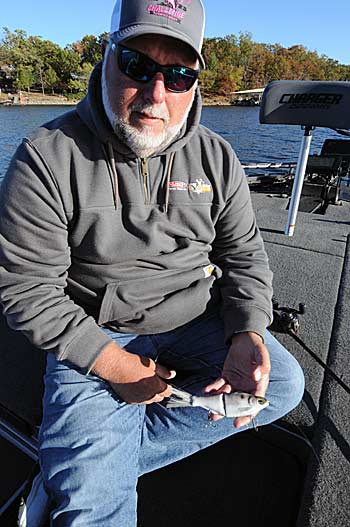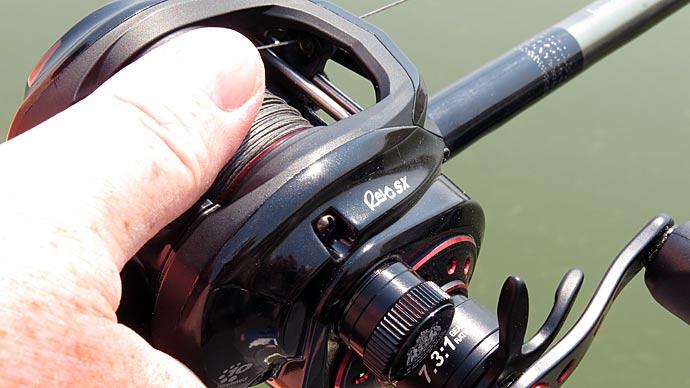
The bait looks big and clumsy, but when retrieved, it glides through the water with the greatest of ease.
The single-jointed hard plastic swimbait known as a glide bait originated as a musky fishing lure but was converted into a bass bait by California and Texas anglers in the late 1980s. Tournament veteran Kelly Power initially fished with Duo Realis glide baits until about seven years ago when he and former Bassmaster Elite Series pro Brian Snowden designed their version of the glide bait, the Extreme Glide (available at extremeoutdoors.us).
The size and lifelike action of the glide bait make it an effective bass catcher. "It best replicates the gizzard shad," Power says. “It kind of offers bass help getting a bigger meal on a regular basis.”
Power estimates the Extreme Glide has a sink rate of about 1 foot per 10 count, which allows him to keep the lure in the bass’ strike zone longer. “I find that the bass I catch when they come up and look at it, I can stop the bait and move it and kind of do some of that erratic movement that just drives the fish nuts,” Power says.
Some lure companies build extra-large glide baits up to 12 to 14 inches long, but Power prefers sizes that match gizzard shad on the lakes he frequently fishes. When he fishes water temperatures around 50 degrees, Power prefers throwing a 7-inch Extreme Glide. In the dead of winter, when the water temperature drops below 50 degrees, he switches to a 9-inch bait. The bigger bait produces better for Power in the winter because a bass' metabolism slows down in the cold water, so the fish eats less often and usually prefers a bigger meal then.
White or shad patterns with a tint of chartreuse are Power's favorite color options for glide baits. "I think the white bait not only makes it easier for me to see the bait, but it also makes it easier for the bass to see it,” he says.
Weather is critical in when and how Power uses his glide bait. "A lot of the best days on the glide bait are windy," Power said. "If you have wind, especially in the fall or spring, that bite increases dramatically. The heavier the wind, the more bites I get because I can stay in that wind and work that bait, whereas topwater lures and stuff like that aren't as effective."
The Missouri angler gauges the wind to determine the speed of his retrieve. "The calmer it is, and the lighter the breeze, the slower I will fish it," he says. "The heavier the wind, the faster I will fish it." Power steadily reels his glide bait most of the time, but if he sees a bass follow the lure, he switches to a stop-and-go retrieve.
Power prefers throwing the glide bait in clear or tinted water where bass can see the bait better and chase it down. "In the stained water, you have to be a little more precise on how you fish the glide bait," he says.

Banks with large or broken rock less than 10 feet deep but close to deep water are Power's favorite spots to throw his glide bait throughout the year. During the dead of winter, Power fishes his glide bait around standing timber on his home waters of Table Rock Lake. He casts the lure past the timber, reels it up to a tree, then stops the bait and lets it sink next to the cover to trigger a strike.
A big glide bait can be challenging to cast accurately, so Power relies on a 7-foot medium-heavy action Virtus rod with a soft tip for throwing the lure. He claims the rod's soft tip gives him better control of the lure as he casts it. Power retrieves his glide bait with a 6.3:1 gear ratio baitcast reel filled with 25-pound fluorocarbon line.
The glide bait produces both numbers of bass and quality fish for Power. "When it is on, it can be an excellent big fish bait," Power says. He notices the average-size bass he catches on the glide bait weighs around 3 pounds, but Power has caught several 4- and 5-pounders on the Extreme Glide, and it produced an 8-pound, 2-ounce largemouth for his son this past spring.
Through trial and error, Power has learned about the virtues of glide bait fishing, but he has noticed some anglers make the mistake of giving up on the lure too soon. “I just think they don’t commit to it enough,” Power says. “I don’t think they truly understand how it works. I think it is intimidating to them because it is a big bait, so they have a hard time committing and truly fishing it enough to get the bites. They might use it for a bit, then quit it because they think nothing will bite it.”
Anglers who stick with the glide bait and figure out how the fish want it and what type of bank to fish it on will eventually catch bass on the big lure. "It is just going out and finding fish like everything else we do," Power says.
BassResource may receive a portion of revenues if you make a purchase using a link above.




